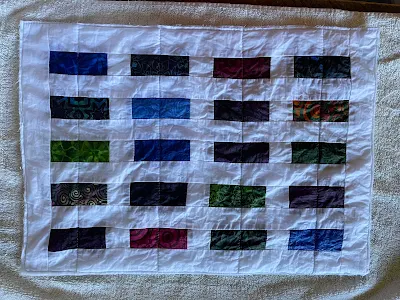One of the topics that was brought up in a zoom event I did recently was the question of whether or not to prewash batiks. I think this is a personal decision, but you should always consider the colorfastness of the fabric and the intended use of the finished quilt. I tend to not pre-wash as I like the way the fabric feels and presses before washing most of the time. I feel that because of the way batik fabrics are manufactured that they tend to be mostly colorfast, but I have experienced some color migration from time to time - I'll elaborate on that further on!
I was concerned that the recipient of my Birthday Prism's quilt might not take the care in washing that I would recommend, so I decided to make a test piece and launder it to see if I thought it might be a problem.
Here's the back, I just sewed a bunch of scraps together with white strips, added backing and batting and stitched it all together. I didn't bother with binding it, since I just wanted to test to see if the colors would bleed when washed.
Ready to add soap and water - I'm just handwashing this in my bathroom basin. I always use cold water, and a small amount of regular laundry soap.
As I added the water, I watched for any signs of color coming off the fabric swatches. I used my hands to agitate the soap and water all through the quilt. The water stayed clear, and no sign of bleeding so far!
After washing I rolled the small quilt in a towel and wrung out the excess water. The color seen around the edges of the patches in this picture is just the seam allowances showing through, as the white is a little transparent when wet. I didn't want to run just this small item through the dryer, so I put it out in the sun to dry. Since it was a nice warm day, this took very little time!
Hurray, no sign of any dye migrating to the white at all! At this point I would be confident in washing the quilt, though I would definitely move the quilt from the washer to the dryer as soon as it was finished with the wash cycle. Generally, if dye is going to migrate from the colored patches to the white, it will happen when it sits damp for a longer period of timer. It's always best to dry as soon as you can to prevent any bleeding. I also will use a color catcher in the wash if I am concerned about fabric dye transfer, and it seems to work well.

This quilt did sit damp for a period of time, and you can see that there was some bleeding around the dark purples. I'm hoping that this will come out in the next wash, but since it's a personal quilt that the cat sits on, I'm not too worried about it! Here is a good article about the reasons fabrics bleed and what to do about it:
How to Stop Fabric Color Transfer, Bleeding and Fading. I will definitely bookmark this one for future reference.
So what do you think? Do you worry about fabric bleeding and what steps do you take to prevent it?








3 comments:
Thank you for the link, I am bookmarking that info. I do use cold water and color catcher sheets if I do not have a really hot and sunny day to dry something outside. I did learn not to let anything set when wet too... so maybe machine drying is the best route?.....
Many years ago (mid 1990’s) I had one batik that I think a washed several times with all kinds of products and it just did not want to quit fading. It was a dark blue batik but I haven’t had much problem in recent years.
I prewash when I can...having been burnt a few times. That said, I always prewash quilts I give now...with color catchers and things go pretty well. There was a line of batiks that bled horribly - not Island Batik which I have yet to see bleed.
Post a Comment